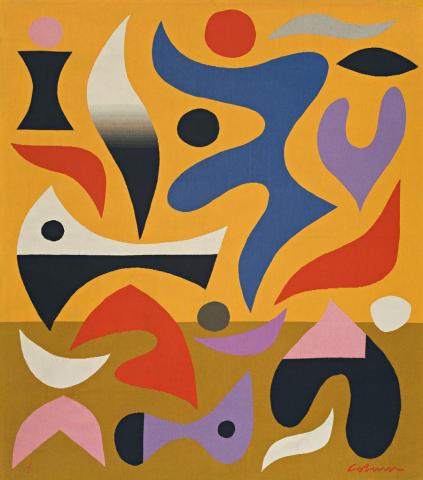BYZANTIUM, c.1974
JOHN COBURN
woven wool tapestry
204.0 x 180.0 cm
signed lower right: coburn, inscribed with title on label verso
Private collection, United States of America
Private collection, United Kingdom
Maquette for Tapestry Byzantium, 1974, screenprint, 59.7 x 52.0 cm,
Susanin's Auctions, Chicago, 3 December 2005, lot 30256207
Byzantium, fibre-tipped pen and pencil, one of nine designs, titled,
in Sketchbook of designs, Paris 1970–73, sheet 37.0 x 31.4 cm,
National Gallery of Australia, Canberra, gift of Doreen Coburn 2007
John Coburn has long been recognised as one of, if not, Australia's finest designer of tapestries. His magnificent Curtain of the Sun 1971 and Curtain of the Moon 1971 for the Sydney Opera House are not only among the largest tapestries in the world, but are also the best in Australia. The 1966 invitation to design tapestries for the world-renowned French Aubusson Workshops resulted in brilliantly colourful individual tapestries such as Byzantium, which was woven at the Pinton atelier, as well as magnificent series such as the Seven Days of Creation tapestries in the Kennedy Centre, Washington. Over eighty of his designs have been woven at Aubusson.
Coburn's art is ideally suited to tapestry design. Grand in concept, his designs translate readily into a scale suitable for wall hangings. Stylistically, the overall flatness adds to the highly decorative nature of his work, completely in harmony with the clarity of form and bright; colours that typify his best. Coburn himself said, 'My style is precise, clear and deliberate.'1 Although his forms are largely biomorphic and geometric in appearance, they take on a heraldic note engendered by a sonorous quality that flows from their marriage of vivacious forms and colours. Floating images echo and offset each other as they pulsate with life. Although Coburn occupies a highly respected position as one of Australia's leading abstract artists, his art is much inspired by nature and the rich varieties of the landscape. Speaking about another tapestry, Coburn said, 'Some of the shapes ... could appear to be like birds, but they are ambiguous, deliberately, because I like all my shapes to be ambiguous so that people can read other things into them what they like.'2 A mood of joyous celebration pervades all his work. This is readily found in Byzantium where colourful shapes clothed in seductive reds, pinks, mauves and blues sport across a simple field of colour, part yellow, part fawn. The introduction of the neutrals black, white and grey provide visual anchors within this feast of splendour, all recalling the exotic richness of fabled Byzantium where East meets West in unrivalled splendour.
1. Quoted in Klepac, L., John Coburn: The Spirit of Colour, The Beagle Press, Sydney, 2003, p. 104
2. ibid.
DAVID THOMAS
